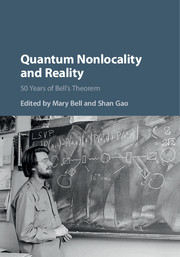Book contents
- Frontmatter
- Contents
- Contributors
- Preface
- Preface
- Part I John Stewart Bell: The Physicist
- Part II Bell's Theorem
- Part III Nonlocality: Illusion or Reality?
- Part IV Nonlocal Realistic Theories
- 19 Local Beables and the Foundations of Physics
- 20 John Bell's Varying Interpretations of Quantum Mechanics: Memories and Comments
- 21 Some Personal Reflections on Quantum Nonlocality and the Contributions of John Bell
- 22 Bell on Bohm
- 23 Interactions and Inequality
- 24 Gravitation and the Noise Needed in Objective Reduction Models
- 25 Towards an Objective Physics of Bell Nonlocality: Palatial Twistor Theory
- 26 Measurement and Macroscopicity: Overcoming Conceptual Imprecision in Quantum Measurement Theory
- Index
- References
25 - Towards an Objective Physics of Bell Nonlocality: Palatial Twistor Theory
from Part IV - Nonlocal Realistic Theories
Published online by Cambridge University Press: 05 September 2016
- Frontmatter
- Contents
- Contributors
- Preface
- Preface
- Part I John Stewart Bell: The Physicist
- Part II Bell's Theorem
- Part III Nonlocality: Illusion or Reality?
- Part IV Nonlocal Realistic Theories
- 19 Local Beables and the Foundations of Physics
- 20 John Bell's Varying Interpretations of Quantum Mechanics: Memories and Comments
- 21 Some Personal Reflections on Quantum Nonlocality and the Contributions of John Bell
- 22 Bell on Bohm
- 23 Interactions and Inequality
- 24 Gravitation and the Noise Needed in Objective Reduction Models
- 25 Towards an Objective Physics of Bell Nonlocality: Palatial Twistor Theory
- 26 Measurement and Macroscopicity: Overcoming Conceptual Imprecision in Quantum Measurement Theory
- Index
- References
Summary
Abstract
In 1964, John Stewart Bell famously demonstrated that the laws of standard quantum mechanics demand a physical world that cannot be described entirely according to local laws. The present article argues that this nonlocality must be gravitationally related, as it comes about only with quantum state reduction, this being claimed to be a gravitational effect. A new formalism for curved space–times, palatial twistor theory, is outlined, which appears now to be able to accommodate gravitation fully, providing a nonlocal description of the physical world.
Nonlocality and Quantum State Reduction
Although quantum entanglement is a normal consequence of the unitary (Schrödinger) evolution U of a multiparticle quantum system, this evolution is nevertheless local in the sense that it is described as the continuous (local) evolution in the relevant configuration space. What the EPR situations considered by John Stewart Bell [1] demonstrated was that when widely separated quantum measurements, of appropriate kinds, are performed on such entangled states (a current record for distance separation being 143 km, for entangled photon pairs [2]), the results of such measurements (which may be probabilistic or of a yes/no character) cannot be mimicked by any local realistic model. Thus, in trying to propose a mathematical model of what is going on realistically in the physical world, one would need to face up to the actual physical process involved in quantum state reduction R, which is an essential feature of quantum measurement.
For many years, my own position on the state-reduction issue has been that R would have to involve a fundamental mathematical extension of current quantum theory, giving a description of something objectively taking place ‘out there’ in the physical world (OR: objective reduction), rather than R being the effect of some kind of ‘interpretation’ of the standard unitary quantum formalism. Moreover, the extended theory should be able to describe the one physical world that we all experience, rather than some sort of coexisting superposition of vast numbers of alternatives. To be more specific about my own viewpoint, it has long been my position that such necessary deviation from unitarity U in this OR would result from a correct melding of the quantum formalism with that of general relativity.
- Type
- Chapter
- Information
- Quantum Nonlocality and Reality50 Years of Bell's Theorem, pp. 400 - 418Publisher: Cambridge University PressPrint publication year: 2016
References
- 1
- Cited by



